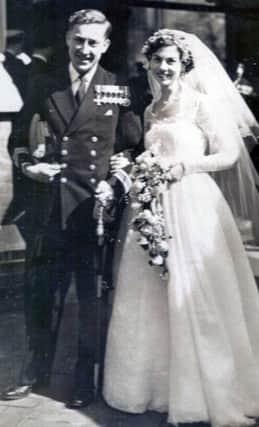Obituary: James Paterson, naval officer and clergyman honoured for Arctic Convoy bravery


James Paterson, a 20-year-old Royal Navy sub-lieutenant from Montrose, kept the guns firing of the destroyer HMS Foresight on Arctic convoy QP 11 after she had been hit, and while enemy attacks continued in the icy waters of the Barents Sea.
He then took over the duties of the ship’s first lieutenant, who was badly wounded, for the remainder of the action and for the rest of the voyage from Murmansk, Russia, to Reykjavik, Iceland.
Advertisement
Hide AdAdvertisement
Hide AdThat convoy of merchant ships under naval escort, and Paterson’s previous one, PQ14, which met heavy pack ice on the way out to Murmansk, are picked out by Winston Churchill in The Hinge of Fate as illustrations of how, that spring, “the difficulties and perils of the convoys grew” and “[they] suffered an increasing scale of attack”.
HMS Foresight’s four 4.7 in Mark IX guns were controlled from the director tower, Paterson’s station as gunnery control officer (GCO). The severing of an electrical connection in the attack meant the director no longer worked, and he had to go round the gun positions, now firing on local control, telling crews the necessary training and elevation.
Paterson’s conduct won him the Distinguished Service Cross: “Sub-Lieutenant Paterson… displayed considerable initiative, worked ceaselessly until all damage to the ship was well under control”, the citation says, ”and by his manner and bearing inspired the men working under him”.
Events during QP 11 included Foresight’s taking the light cruiser Edinburgh into tow back towards Murmansk after the cruiser had been hit by a U-boat; this, too, Churchill notes in his history. The tow broke; on 2 May three enemy destroyers were seen, and it was decided to scuttle Edinburgh. She sank in 840ft of water. Ingots of gold, which she had been carrying as Russia’s payment for Allied supplies, would be salvaged from the wreck in 2010.
James Beresford Paterson was grandson of the artist James Paterson, of the “Glasgow Boys” group. He served in the doomed Norway campaign in 1940 in the light cruiser HMS Enterprise, supporting shore operations at Narvik. His father, Fergus, was a Glasgow engineer who had been a beachmaster at Gallipoli; an uncle was a Royal Navy captain. Paterson, eldest of five children, was educated from the age of 13 at Britannia Royal Naval College, Dartmouth. He joined Enterprise after training on the cruiser HMS Vindictive.
After his Arctic prowess, Paterson was in HMS Foresight to escort an Atlantic convoy to Halifax, Nova Scotia; and to take part in Operation Pedestal, the celebrated convoy that in August 1942 just managed, despite concentrated attacks, to deliver the American tanker SS Ohio, under a British crew, with fuel to besieged Malta. Foresight was damaged: on orders to abandon her, Paterson, now lieutenant, transferred with others to HMS Tartar.
Later in the war he was with the destroyer HMS Quadrant in the Indian Ocean and Far East, in charge of the Asdic cabinet and dropping depth-charges. He did the signals long course at HMS Mercury near Petersfield, Hampshire; danced with Princess Elizabeth at the Victory Ball in 1945; then was signal communication officer (SCO) of the staff of flag officer (air); and flag lieutenant to the admiral as SCO2 at Lee-on-Solent, Hampshire. He became fleet communications assistant in the battleship Duke of York in 1947.
He met his future wife, Susan Alston, in Suffolk when, as an instructor at HMS Ganges at Shotley on the River Orwell, he was invited to lunch by her family, who knew his; they too, were originally engineers from Glasgow. The couple married in 1951 at St Paul’s, Knightsbridge, and were to have a daughter, Jane, and two sons, Simon and Quentin. Susan died in 2015; his children survive him, as do his sisters Anne, Elizabeth and Jennifer, and his brother, Robin.
Advertisement
Hide AdAdvertisement
Hide AdPaterson was in HMS Belfast, refitting at Tokyo, from 1951 during the Korean War of 1950-53, and became interested in philosophies of the Far East. He was an instructor at staff college, Greenwich, being promoted commander in 1955.
A quiet, thoughtful man, often seen wearing tweeds, and with a green coat and hat, he was a skilled draughtsman of ships and landscapes in pen and ink and watercolour. He also made cartoons, and hand-drawn Christmas cards for his family.
In 1959 he decided to train for the ministry; influences on his thought included books by the adventurer Julian Duguid, Aldous Huxley, and the 17th century Benedictine monk Father Augustine Baker. After Westcott House, Cambridge, he was curate at St Mary’s, Woodbridge, in Suffolk, then Scottish Episcopal Church rector at St Mary’s, Broughty Ferry, and at Glencarse, Perth.
Ecumenical matters were important to him, and he served from 1972-79 as secretary to Scottish Churches Action for World Development.
He invented, fixed things, and made tree-houses; and taught children and cousins to sail dinghies, and to drive in a Volkswagen Microbus. He also devised for himself a red-sailed triangular Chinese-style junk rig for single-handed trips on holidays in the waters off the Black Isle.
ANNE KELENY